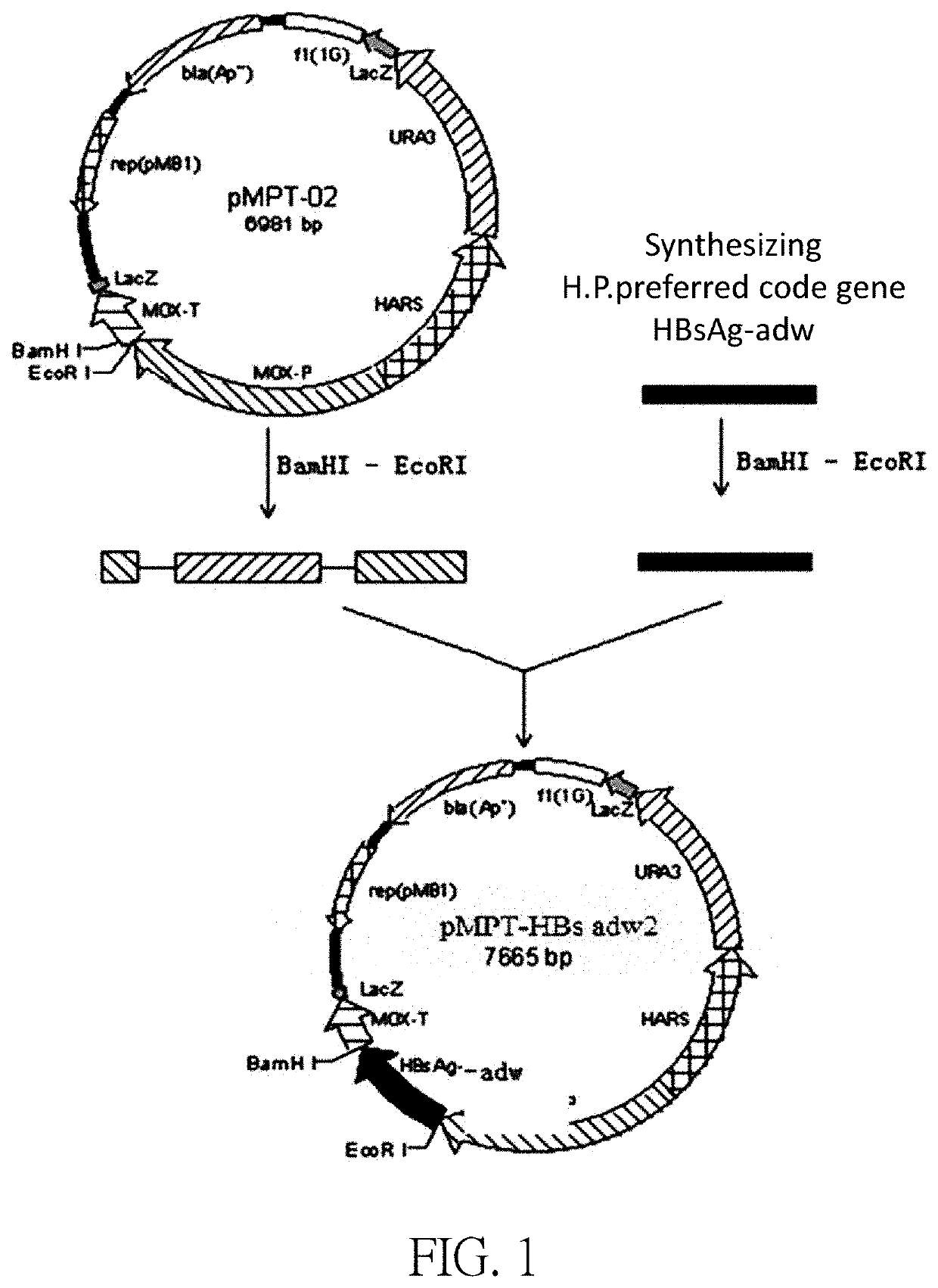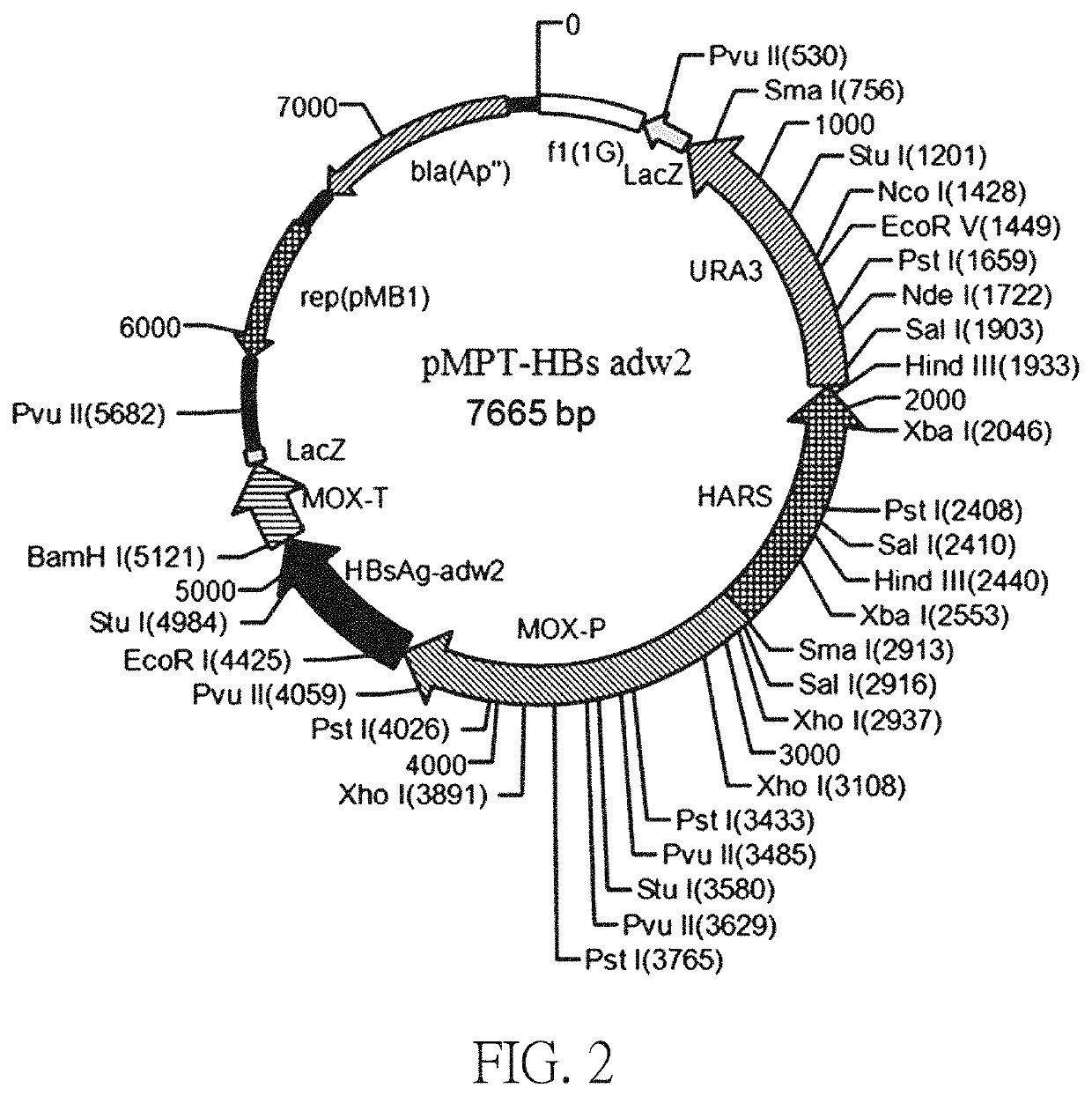Hepatitis B treatment vaccine on the basis of inactivated, whole recombinant Hansenula polymorpha cells expressing HBsAg
a hansenula polymorpha, inactivated technology, applied in the field of genetic engineering, can solve the problems of hbv infection, endanger people's health, hinder social development, etc., and achieve the effect of enhancing the immune tolerance status, maximizing the amount of hbsag injected, and enhancing the reversal of immune toleran
- Summary
- Abstract
- Description
- Claims
- Application Information
AI Technical Summary
Benefits of technology
Problems solved by technology
Method used
Image
Examples
first embodiment
[0061]The pMPT-HBsAg adw2 plasmid was constructed based on the sequence of SEQ ID NO: 1 (an expression vector comprising the sequence of the SEQ ID NO: 1). The construction of plasmid pMPT-HBs adw2 includes the following steps:
[0062]The HBsAg adw2 gene was synthesized according to the DNA sequence of SEQ ID NO: 1; and the glycerol strain containing the HBsAg adw2 gene plasmid was constructed and named as MC407B-16.
[0063]The correctly sequenced MC407B-16 plasmid was digested with EcoRI / BamHI, and the digested product was used a TaKaRa PCR Fragment Recovery Kit (Code No. D301) to recover 701 bp DNA fragment called Inset DNA6.
[0064]The correct plasmid pMPT-02 was digested with EcoRI / BamHI, and the vector DNA obtained from the DNA recovery kit was called Vector DNA6.
[0065]Inset DNA6 was ligated to Vector DNA6 by using Solution of the TaKaRa DNA Ligation Kit (Code No. D6022), and then thermally transformed into E. coli Competent Cell JM109 (Code No. D9052), and the cells were plated in t...
second embodiment
[0067]Construction of a recombinant H. polymorpha HBsAg engineered strain (i.e., a H. polymorpha host cell transformation screening strain includes the sequence of SEQ ID NO: 1).
[0068]The transformation and screening process of the recombinant H. polymorpha was shown in FIG. 5:
[0069]Specifically
[0070]1) The pMPT-HBsAg plasmid was transformed into the URA3-auxotrophic H. polymorpha cell strain HU-11 (CGMCC No. 1218) of the host cell by cell electroporation. The culture medium was selected using a selection medium (MD liquid medium). The single colony transformants were picked up on the MD selection culture plate and transferred to the MD liquid medium for continuous subculture. The adw2 subtype HBsAg gene and the corresponding regulatory components were multi-copy and heterologously integrated into the host H. polymorpha cell chromosome.
[0071]2) Strain screening included the following steps
[0072](1) Selecting a single colony of uracil prototrophic transformants
[0073]Colonies with rap...
third embodiment
[0079]The main process of 30 liters of pilot fermentation:
[0080]1) strain stored in liquid nitrogen was thawed by 200 ml seed medium, inoculated into the medium, divided into two 0.5 L shake flasks, and cultured at 31° C. for 22 hours as a first-class seed;
[0081]2) the primary seed was transferred into the secondary seed culture medium with 1600 ml seed medium, divided into six 1 L shake flasks, and incubate at 31° C. for 20 hours as a secondary seed;
[0082]3) 12 L fermentation medium was adjusted to pH 5.5 and transferred into a 30 L fermenter, and then the secondary seed was inoculated under growing at 30-31° C. through two sources of glycerol and methanol; growth, de-repression and induction for the three phases, and co-culture 85 to 96 hours, the cells were harvested after 2-3 hours stopped induction. The frozen cells are homogenized.
[0083]Operation Points:
[0084](1) The feeding operation of the growth phase was going when the dissolved oxygen was consumed and the basal medium was...
PUM
| Property | Measurement | Unit |
|---|---|---|
| concentrations | aaaaa | aaaaa |
| temperature | aaaaa | aaaaa |
| temperature | aaaaa | aaaaa |
Abstract
Description
Claims
Application Information
 Login to View More
Login to View More - R&D
- Intellectual Property
- Life Sciences
- Materials
- Tech Scout
- Unparalleled Data Quality
- Higher Quality Content
- 60% Fewer Hallucinations
Browse by: Latest US Patents, China's latest patents, Technical Efficacy Thesaurus, Application Domain, Technology Topic, Popular Technical Reports.
© 2025 PatSnap. All rights reserved.Legal|Privacy policy|Modern Slavery Act Transparency Statement|Sitemap|About US| Contact US: help@patsnap.com



